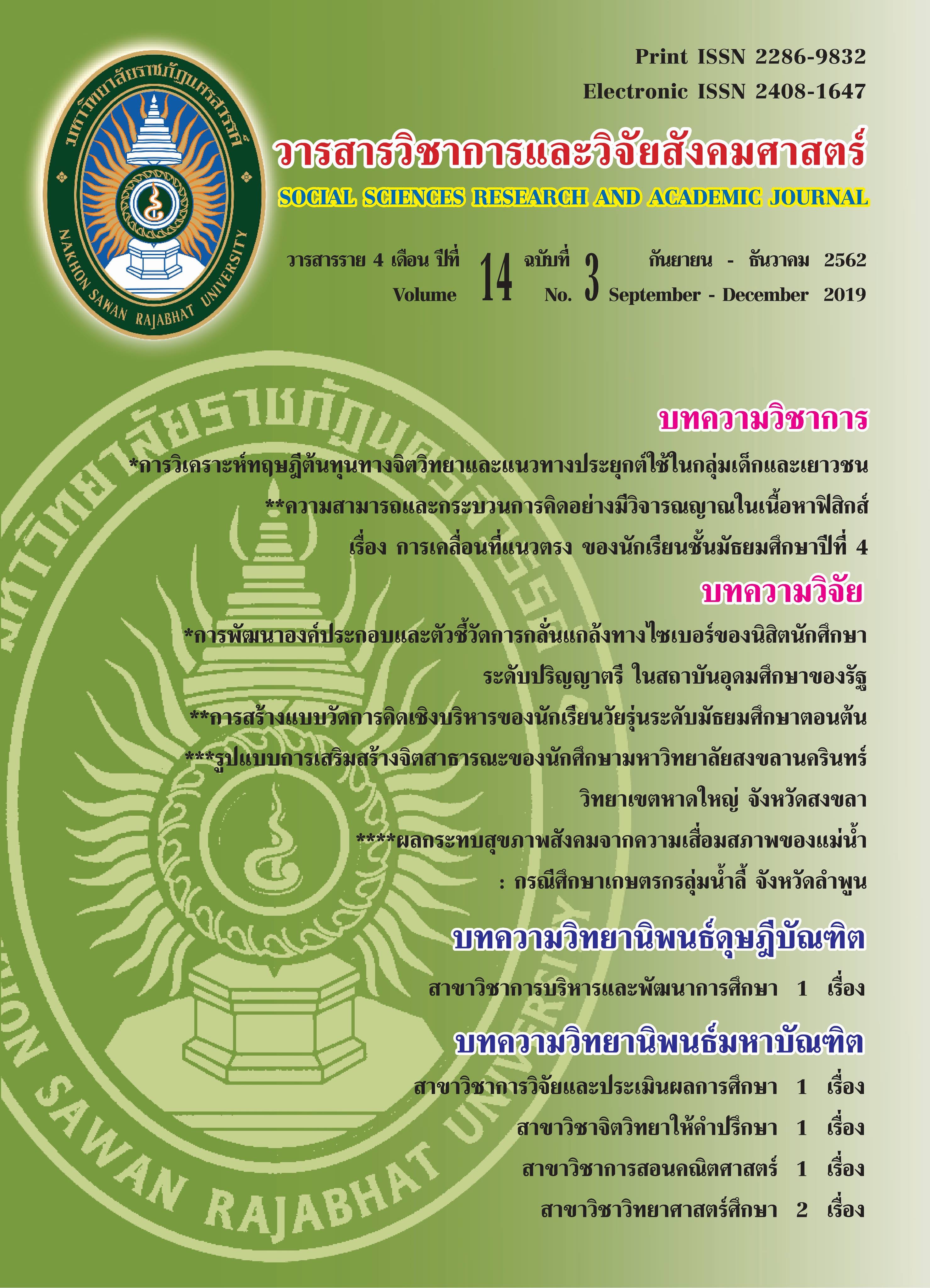การวิเคราะห์ทฤษฎีต้นทุนทางจิตวิทยาและแนวทางประยุกต์ใช้ในกลุ่มเด็กและเยาวชน Analysis of Psychological Capital Theory and Application Guidelines for Children and Youth Groups
Main Article Content
Abstract
ต้นทุนทางจิตวิทยาเป็นทรัพยากรเชิงบวกภายในตัวบุคคลที่สามารถวัด พัฒนา และเปลี่ยนแปลงได้ ทรัพยากรเหล่านี้จะเป็นเหมือนภูมิต้านทานของจิตใจเมื่อบุคคลต้องเผชิญกับปัญหาที่ก่อให้เกิดความเครียด ความเศร้า หรือความรู้สึกในด้านลบต่าง ๆ ที่อาจนำไปสู่ปัญหาสุขภาพจิตในอนาคตได้ มีงานวิจัยจำนวนมากให้การสนับสนุนว่า ผู้ที่มีระดับต้นทุนทางจิตวิทยาอยู่ในระดับสูงมีความเสี่ยงที่จะเกิดปัญหาสุขภาพจิตน้อยกว่าผู้ที่มีต้นทุนทางจิตวิทยาในระดับต่ำ และจากสังคมปัจจุบัน เด็กและวัยรุ่นต้องเผชิญกับความกดดันทั้งจากภายในและภายนอกซึ่งส่งผลต่อสุขภาพจิตและความเป็นอยู่ที่ดีของบุคคล ด้วยเหตุนี้ จึงควรมีการศึกษาและหาแนวทางการพัฒนาต้นทุนทางจิตวิทยาในกลุ่มเด็กและเยาวชนเพื่อเป็นเกราะคุ้มกันทางจิตใจให้เด็กเหล่านั้นมีความเป็นอยู่ที่ดีต่อไปในอนาคต
Psychological capital (PSYCAP) is the positive characteristic which individuals can be measure, develop, and enhance their abilities. We can use these positive resources as immunity to psychological problems (such as stress, depression or other negative feelings) which may lead to mental health problems in the future. There are several studies support that the higher level of individual’s PSYCAP, the less risk of mental health problems than those who have lower PSYCAP level. Today, children and youths are stressed and pressured by internal and external factors that affect mental health and well-being of individuals. For this reason, we should study and develop PSYCAP in children and youth groups to use as psychological protection for those children to achieve well-being in the future.
Article Details
References
Bandura, A. (2006). Guide for Constructing Self-efficacy Scales. Self-Efficacy Beliefs of Adolescents, Information Age Publishing: 307-337.
Bandura, A. (2001). Social Cognitive Theory: An Agentive Perspective. Annual Review of Psychology, 52, 1-26.
Bitsika1, V., Sharpley, F. C. & Peters, K. (2010). How is resilience associated with anxiety and depression? Analysis of factor score interactions within a homogeneous sample. The German Journal of Psychiatry, 13, 9-13.
Carr, A. (2004). Positive Psychology: the Science of Happiness and Human Strengths. New York: Routledge.
Carver, C., Scheier, M., Miller, C., & Fulford, D (2009). Optimism. In S. Lopez & C. R. Snyder (Eds.), Oxford handbook of positive psychology (2nd ed., pp. 303-312). Newyork, NY: Oxford University Press.
Deb, S., Strodl, E., & Sun, J. (2015). Academic stress, parental pressure, anxiety and mental health among Indian high school students. International Journal of Psychology and Behavioral Sciences, 5(1), 26-34.
Dunne, M. P., Sun, J., Do Nguyen, N., Truc, T. T., Loan, K. X., & Dixon, J. (2010). The influence of educational pressure on the mental health of adolescents in East Asia: Methods and tools for research. Journal of Sciences, 109-122.
Gardner, D. M. (2011). Parents' Influence on Child Social Self-Efficacy and Social Cognition. Master thesis, Marquette University.
Larson, M. D., Norman, S. M., Hughes, L. W., & Avey, J. B. (2013). Psychological capital: a new lens for understanding employee fit and attitudes. International Journal of Leadership Studies, 8(1), 28-43.
Luthans, F., Avey, J. B., Avolio, B. J., Norman, S. M., & Combs, G. M. (2006). Psychological capital development: toward a micro‐intervention. Journal of Organizational Behavior: The International Journal of Industrial, Occupational and Organizational Psychology and Behavior, 27(3), 387-393.
Luthans, F., Youssef-Morgan, C. M., & Avolio, B. J. (2015). Psychological Capital and Beyond. Oxford University Press.
Luthans, F., Youssef, C. M., Sweetman, D. S., & Harms, P. D. (2013). Meeting the leadership challenge of employee well-being through relationship PsyCap and health PsyCap. Journal of leadership & organizational studies, 20(1), 118-133.
Maciejewski, P. K., Prigerson, H. G., & Mazure, C. M. (2000). Self-efficacy as a mediator between stressful life events and depressive symptoms: Differences based on history of prior depression. The British Journal of Psychiatry, 176(4), 373-378.
Ong, A. D., Edwards, L. M., & Bergeman, C. S. (2006). Hope as a source of resilience in later adulthood. Personality and Individual Differences, 41(7), 1263-1273.
Seligman, M. E. (2007). The optimistic child: A proven program to safeguard children against depression and build lifelong resilience. Houghton Mifflin Harcourt.
Sinclair, D., Purves-Tyson, T. D., Allen, K. M., & Weickert, C. S. (2014). Impacts of stress and sex hormones on dopamine neurotransmission in the adolescent brain. Psychopharmacology, 231(8), 1581-1599.
Slap, G. B., Khalid, N., Paikoff, R. L., Brooks-Gunn, J., & Warren, M. P. (1994). Evolving self-image, pubertal manifestations, and pubertal hormones: Preliminary findings in young adolescent girls. Journal of Adolescent Health, 15(4), 327-335.
Snyder, C. R., Irving, L. M., & Anderson, J. R. (1991). Hope and health. Handbook of social and clinical psychology. The health perspective, 162, 285-305.
Tusana T, Patcharin N, & Sopin S. (2013). Factors Predicting Stress in Graduate Nursing Students. Nursing Journal of The Ministry of Public Health, 22(3), 1-11.
Wagnild M. G. (2009). A Review of the Resilience Scale. Journal of Nursing Measurement, Springer Publishing Company, 17(2), 105-113.
Youssef, C.M,& Luthans, F. (2007). Positive organizational behavior in the workplace: The impact of hope, optimism and resiliency. Journal of Management, Sage Publications, Inc., 33(5), 774-800.
Zimmerman, B. J., & Bandura, A. (1994). Impact of self-regulatory influences on writing course attainment. American Educational Research Journal, 31(4), 845-862.


